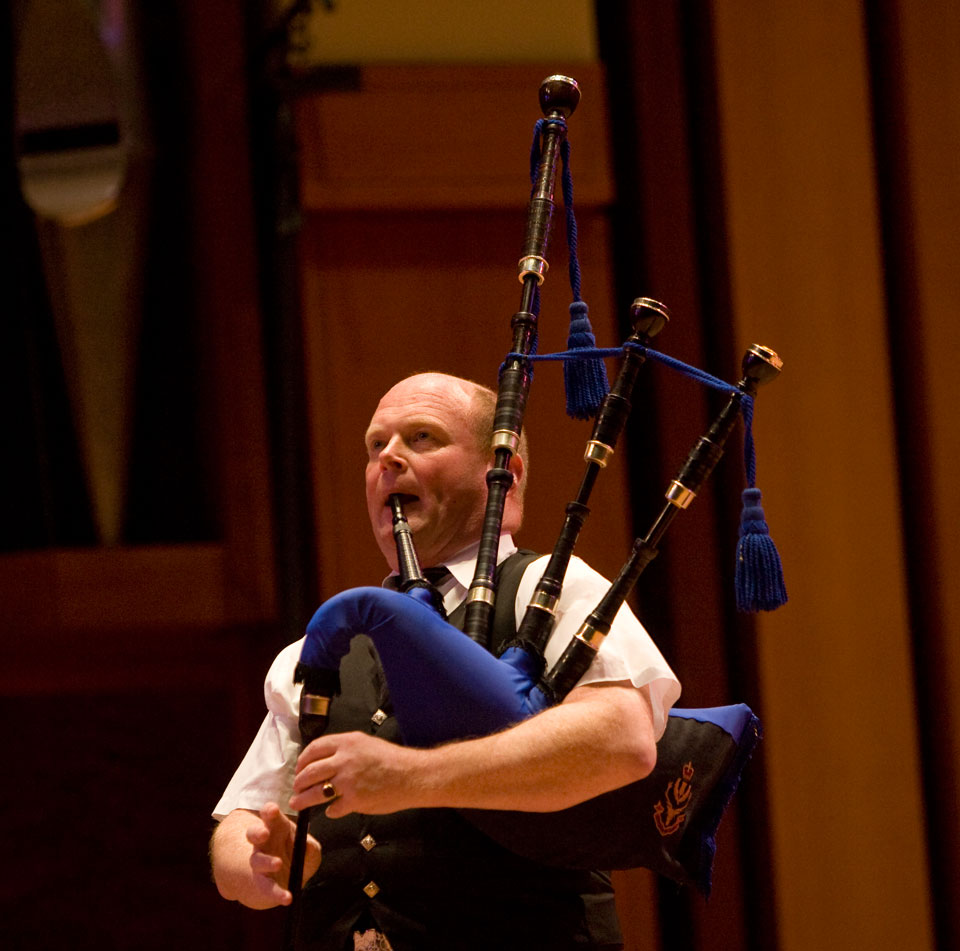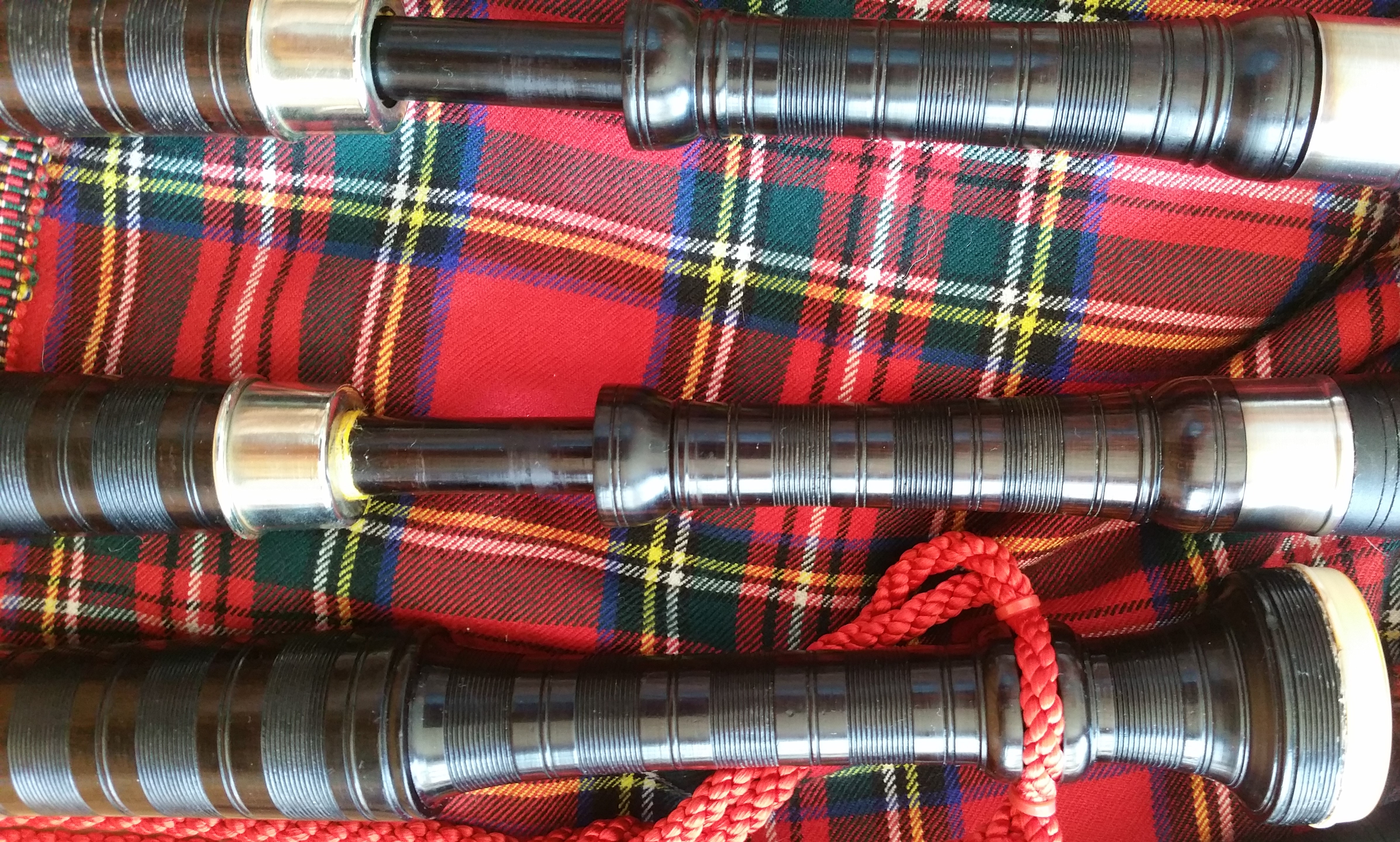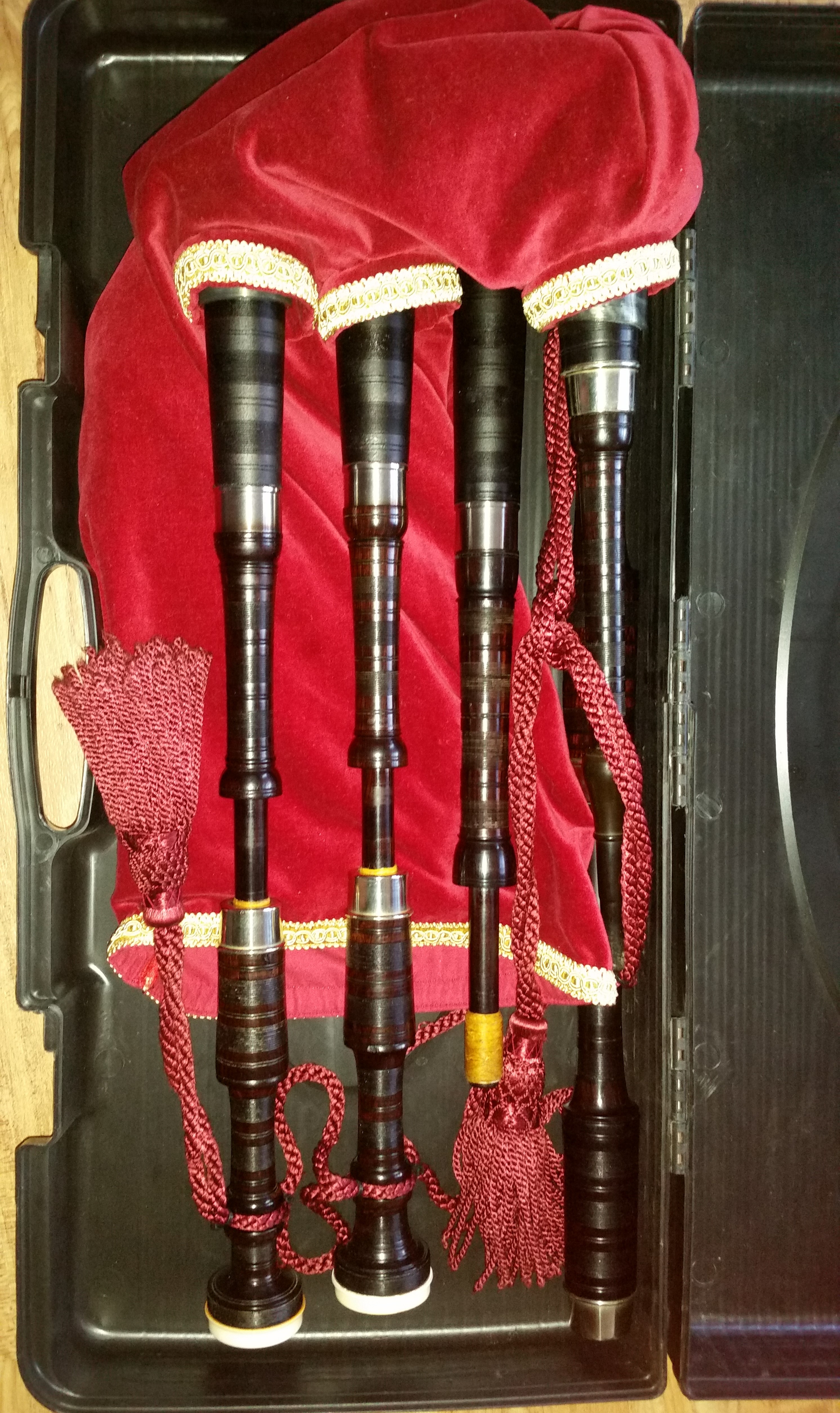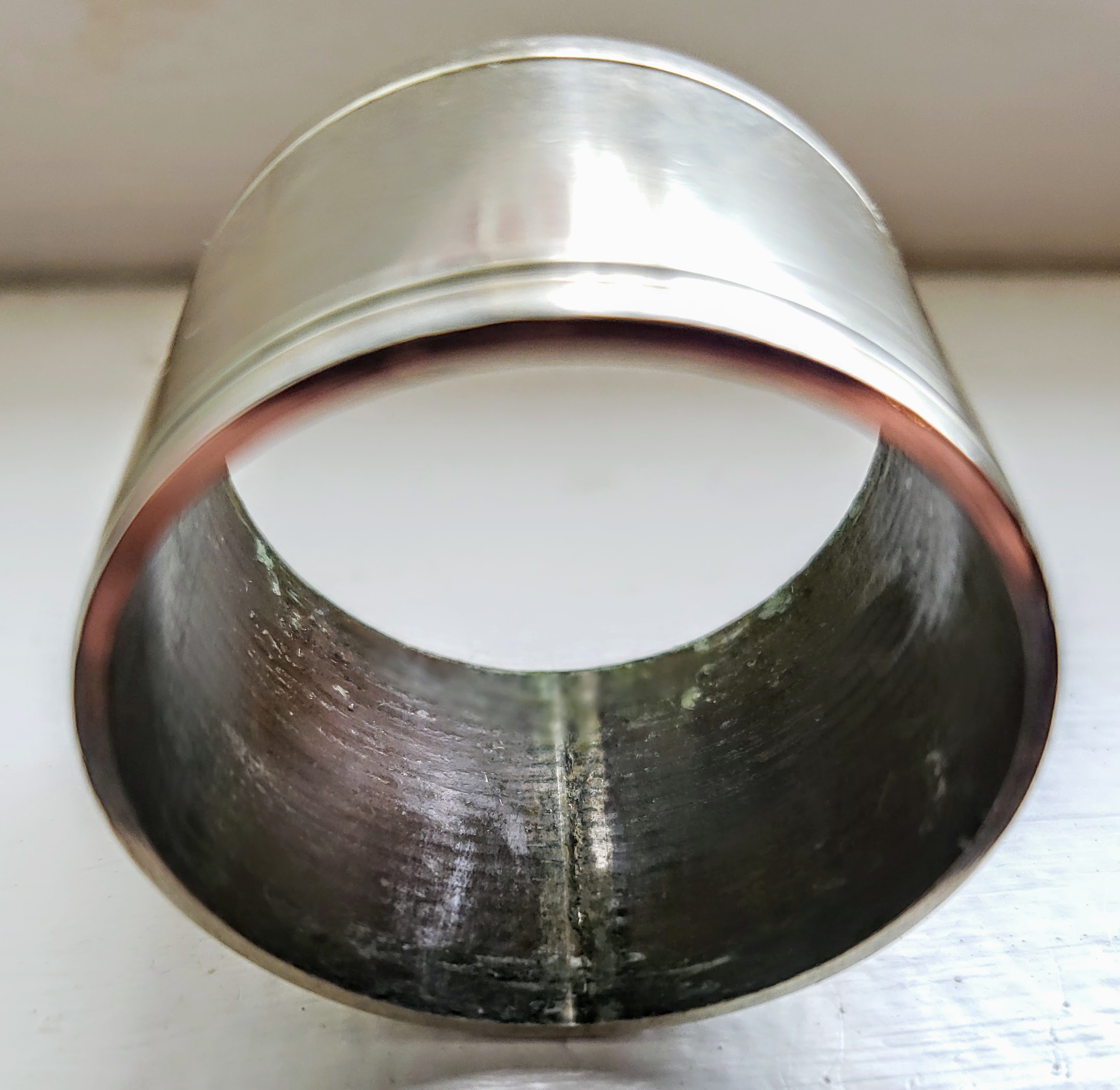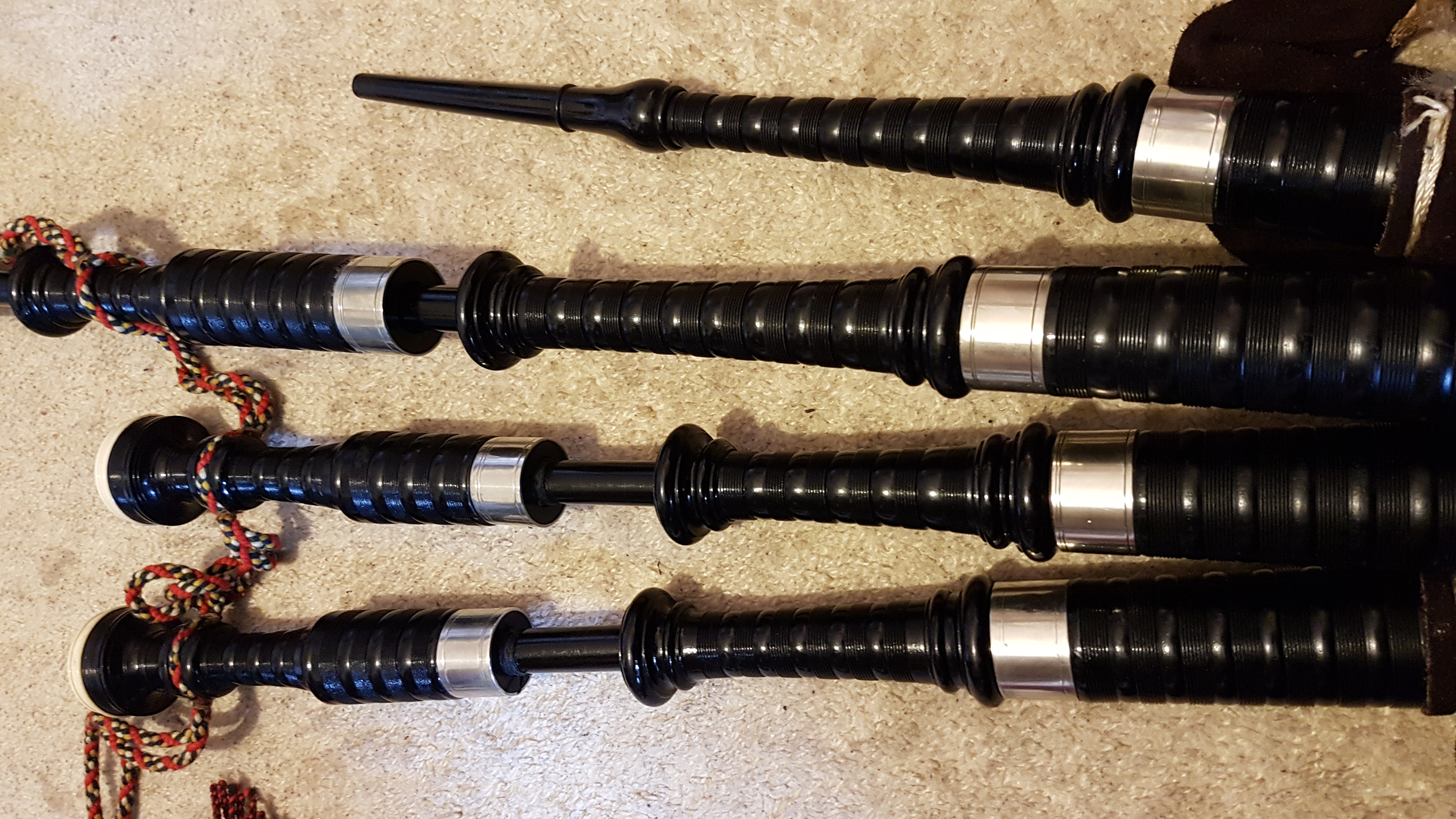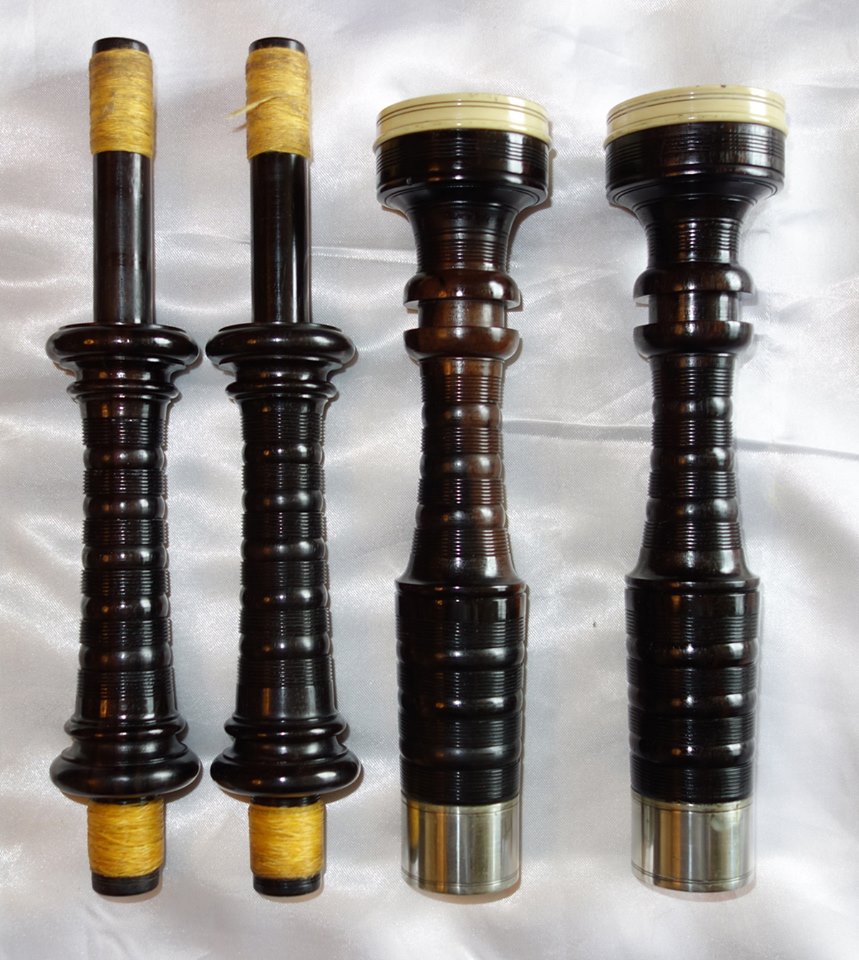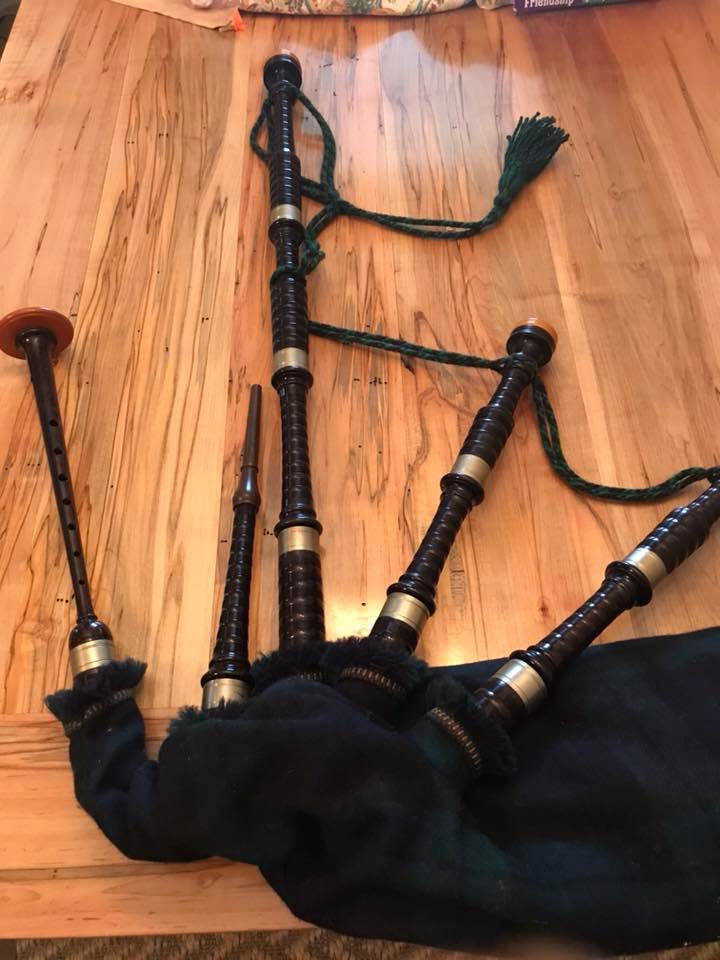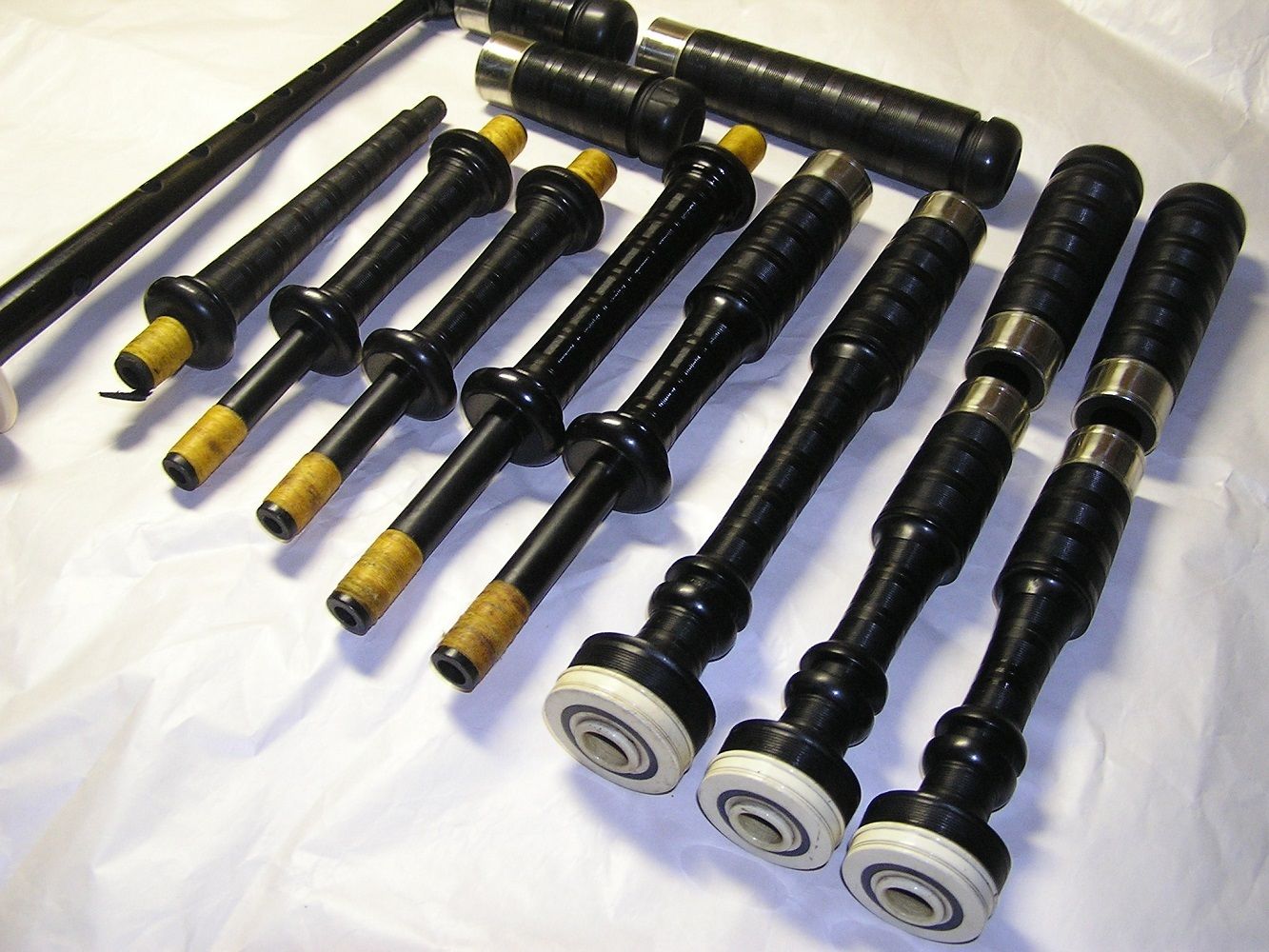Wood-Mount Styles and Possible Associations to Date of Manufacture
Some may have been reading my page on the trials and tribulations of trying to import a set of ebony wood-mounted Lawries with ivory bushes from the UK to Canada. The story is interesting in that we know fairly accurately the date of these pipes by their association with a pipe band that formed around 1920; the Victoria Street Pipe Band acquired their pipes, uniforms, and likely their drums as military surplus. Knowing when these pipes were sold as surplus, i.e., 1920, we can assume that these ex-military bagpipes would have likely been manufactured in the teens and possibly earlier. Investigating these and similar pipes by Henderson got me thinking that there seems to be a number of styles of wood mounts. There are two, three, perhaps even four generations of wood mounts on Lawries and there ‘may’ be a connection with date of manufacture. With Hendersons, it’s a little different, as while they appear in two styles of mounts, dating is more complicated.
Button-mount Vs. Wood-mount
First, let’s separate wood-mounted from button-mounted pipes. There appear to be many examples of early button-mounted pipes by various makers, particularly from Edinburgh but, generally-speaking, not so much by Henderson or Lawrie. Generally-speaking, to some extent, because Lawrie may have made two versions and Henderson, one.
The more common Lawrie version of button-mounted pipes is their ~1930s – 50s flat-turned chalice top design. Alidair Ghillies famously played his father’s button-mounted chalice-topped Lawries. Here’s an image of him with these pipes:
Henderson made a similar version but with catalin. Here’s an example of the same type of Lawrie chalice top (left) and Henderson version (right) together from Ron Bowen’s website:
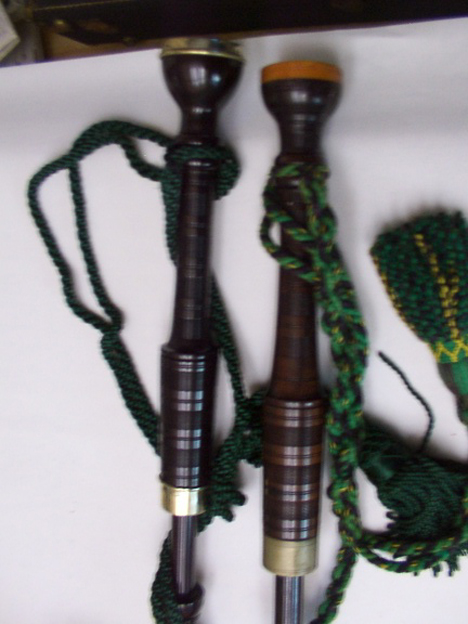
R.G. Lawrie and Peter Henderson Ltd flat-combed, chalice top bass drones. Lawrie’s version is a little more common than the Henderson version, but both are quite scarce. Image from Ron Bowen’s website.
And finally, the single example I could find of a second version of a Lawrie button-mounted pipe, which is also flat-combed. I post these with caution, as this pipe may be comprised of more than one set:
OK, so now that we have this out of the way, we can say that the fuller-sized wood mounted pipes were really the most typical style made by Henderson and Lawrie. Here’s an image of the most typical style wood-mounted pipes from Henderson (I’ll call them Type A, more below)…
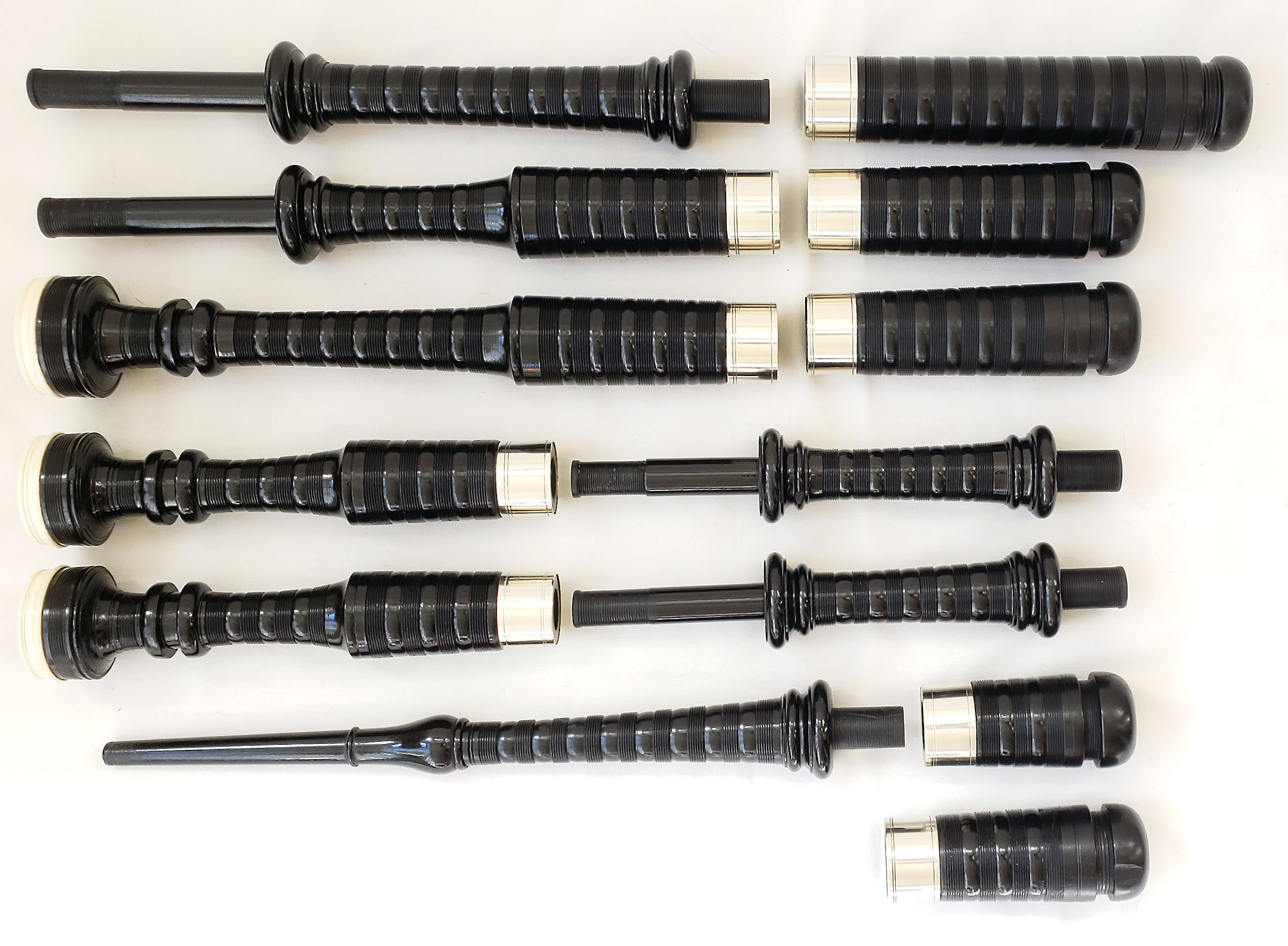
Teens to 1920s ebony and casein wood-mounted Hendersons. I’ve coined this mount style Type A, spool and mushroom mounts, and it’s the most common style we find on wood-mounted Hendersons, found on pipes from the teens to the 1960s and possibly later. More below.
and now one of the two main typical styles of wood-mounted pipes by Lawrie (I’ll call these Generation I.b, more below)…
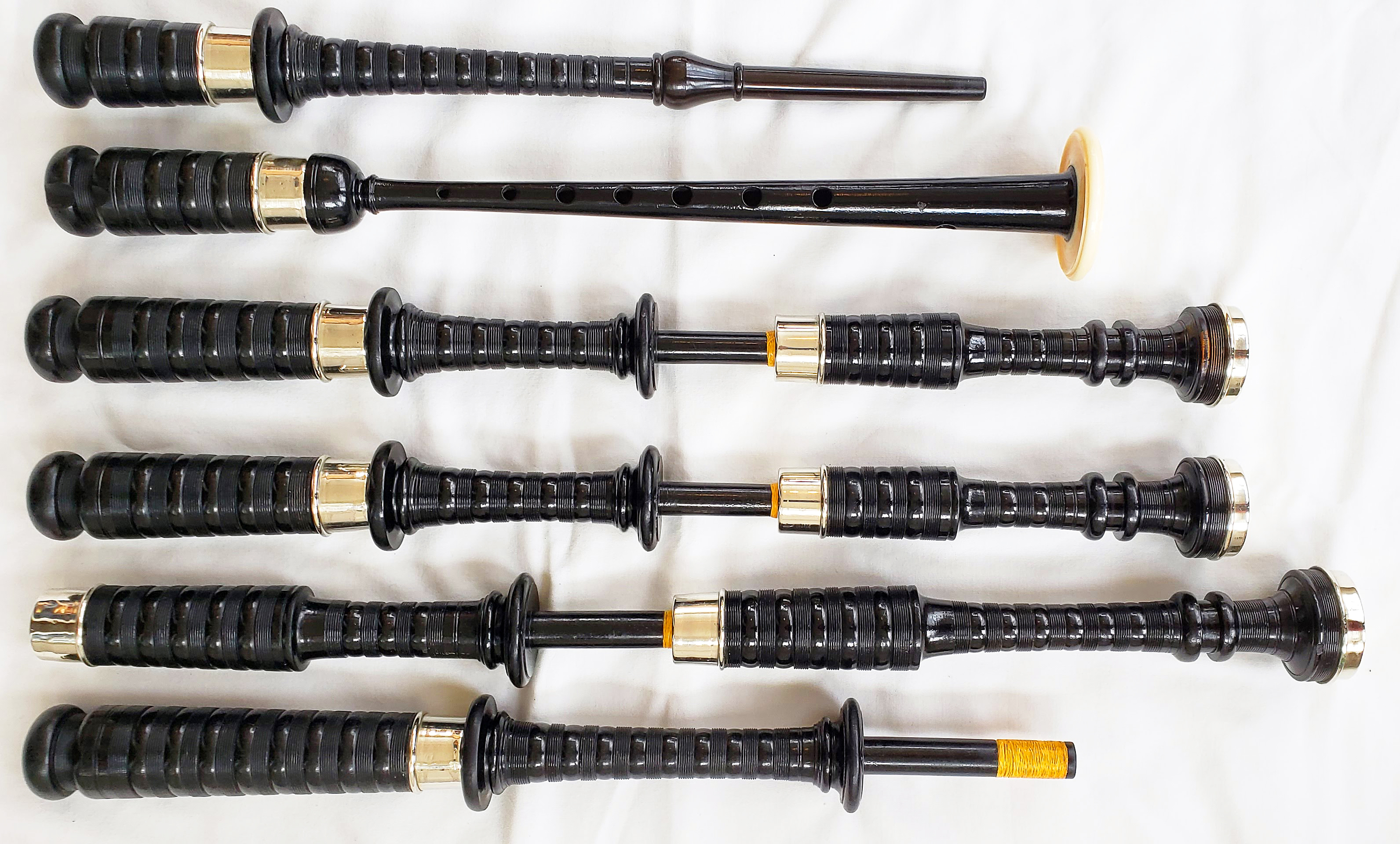
Perhaps the most elegant looking wood-mounted pipes out there: 1910 – 1920 era Lawries. I’ve coined this style Generation I.b, based on the fact it’s pretty much the earliest style and commonly found on WWI – era Lawrie. This style is not as common as Generation II mounts, but I like them the best. More below.
History of Wood-mounted Pipes
We are fairly certain that wood-mounted pipes by R.G. Lawrie can be dated based on ferrule style and ring cap bush material. For example, between 1900 and 1912 the ferrule style was straight and often with scribe lines and ivory or celluloid or both were used for caps and bushes. However, Henderson bagpipe making goes back more than 20 years earlier and it’s hard to peg the earliest dates for those wood-mounted pipes. The earliest wood-mounted Henderson’s I’ve seen are likely from the teens and twenties, given that many of them utilize casein ring caps and bushes, and thick, seamed ferrules, which date them from WWI to maybe 1920. After scanning many years of catalogues of Henderson catalogues, mainly in Jeannie Campbell’s first bagpipe book, the earliest a priori reference to wood-mounted bagpipes I can find is in a 1969 Henderson catalogue:
No. 1 Half-mounted nickel silver, wood projecting mounts, imitation ivory rings and chanter sole (and from the separate price list, 51.
However, wood-mounted pipes were not referred to as wood-mounted in the earliest Henderson catalogues. In a discussion with an astute member of the Dunsire Forum it has become apparent that wood-mounted pipes were simply noted as “half mounted with German silver”. For example, in the 1888 and 1890 Henderson catalogues wood-mounted pipes are described as “4. half mounted with German Silver” (£4), which is the cheapest bagpipe by far on the page. The ring and bush / cap material was not described, I have not seen any nickel-capped Hendersons, so these must have been topped in ivory, certainly for pre-1915ish versions. We can say with some degree certainty that casein was the first non-ivory material used by Henderson, very likely around the beginning of WWI, but more on that below.
Earliest Wood-mounted Hendersons/Lawries?
One would assume that the cheapest sets offered by a pipe manufacturer would be the most common. We know that Henderson was offering wood-mounted pipes as early as 1888. However, very early, say pre WWI wood-mounted pipes by Henderson seem to be incredibly rare. The same can be said for Lawries. There is one cocus wood and ebony set (flat-combed and with Type B mounts Henderson pipes on Jim McGillivray’s site dated as 1905, the only pre-WWI set I am aware of, and I don’t know what criteria were used for the dating. That mount type, Type B if you will, seems to be the rarest Henderson wood mount type (and the opposite of Lawrie which almost always sport those mounts); Henderson seems to have developed and used the Type A spool and mushroom mount exclusively (and which Hardie and others have since copied). There are two or three 1910ish Lawrie wood-mounted pipes out there (based on straight ferrules with scribe lines), but that’s it. So, removing true button mount pipes from the picture, where are these early wood-mounted sets with either mount type? It would seem odd that not many were sold and/or survived.
As noted, I can’t find any direct listing of wood-mounted types in Peter Henderson catalogues until 1969. I find it hard to believe, but maybe Henderson didn’t turn out any wood-mounted sets until the teens; though some Henderson wood-mounted sets have ivory ring caps and bushes, many more have casein (teens – 20s) or catalin (30s +) tops. As a comparison, some of the earliest wood-mounted Lawries can be dated to 1912 or perhaps a little earlier, based on the straight-sided and scribe-lined ferrules, use of celluloid, and overall profile. I can’t seem to find any R.G. Lawrie price lists for bagpipes, only the one you posted a while ago on sporrans, etc.
Thus, in a way, Henderson and Lawrie wood-mounted bagpipes could well be a later addition to their lines. I wonder if the lower price for wood-mounted sets and less ivory used (e.g., casein, celluloid, nickel caps), was targeted at the military, and we certainly have seen evidence of this.
Dating by Materials
One thing we need to keep in mind is that the type of wood will very likely help to highlight the era of manufacture. Cocus wood and ebony appear to be common woods in Lawrie and Henderson pipes from 1900 until perhaps the 1930s, with African blackwood coming into favour after this period. To split this even further, cocus wood is the rarer of the three, so it stands to reason that it would have become rarer first (~1920s), followed by ebony (1930s or 40s), and finally African blackwood (1930s – ?).
Also, with wood-mounted pipes, ring cap and ferrule material is another factor. Ivory was used pretty much from the beginning until almost the present, but artificial materials became alternatives early in the 20th century. Celluloid was used mainly used on Lawries from close to 1900 up until perhaps the 1930s, at least to some degree (recall, that Lawrie ring caps were often comprised of two materials, variations of ivory, celluloid, and catalin). Note, we don’t seem to have any evidence that Lawrie used casein. Casein was used on Henderson pipes perhaps through the 1920s (it was not really commercially available before that). Catalin was used extensively by both Lawrie and Henderson from probably the 1930s (and likely earlier) well into the 1960s or 1970s. Thus, mount style, wood type, and ring cap/ferrule materials are all critical components to dating these pipes.
Wood-mounted Lawries
I am early in this investigation, but at this point I am dividing wood mounts by Lawrie into two broad generations. Generation I wood mounts appear to bear resemblance to typical Edinburgh style ivory/bone mounts, relatively small in diameter and depth. They are more diminutive compared to what we think of as classic bagpipe mounts, and distinctly different. The top part of the upper mount is symmetrical; the top is similar to the bottom. Some would call this spool-shaped. The bottom mounts in Generation I wood mounts follow the smaller diameter of the upper mounts, but vary from more typical in shape with a slight scallop, to quite bulbous-looking. Based primarily on this variability in the lower mounts, I believe that Generation I mounts can be subtly divided into three subgroups (see below).
Generation II wood mounts take quite a diversion in style and are shaped more like traditional Glasgow style ivory mounts, broader than Generation I, but with a variable depth; they do not look spool-like. The lower mount is always scalloped. There may be more than one subdivision of Generation II mounts. The top part of the mount may appear somewhat thinner on some sets but there is no symmetry here; the top half of the upper mount is different from the lower half; it is for more like a quintessential Glasgow mount. Both generations of mounts appear to be found on fully beaded and combed and on flat-combed sets. To isolate the detail, here are images of just the upper and lower tenor mounts on Lawries:

A study of two broad types of wood mounts on Lawries, with the first group divided into two subtly different types. Gen I.a images from Gord MacDonald’s Island Bagpipe, Gen 1.b my pipes, and Gen. II from Jim McGillivray’s Vintage pipes pages. Note, that the date of the first Lawrie above is likely post 1910 given the beading on the ferrules.
Generation I Wood Mounts: 1900 – WWI
As seen above, there are two substyles of Generation I, I.a, I.b, and I.c. The very earliest wood-mounted Lawries, Generation I.a, sported the most diminutive and slightly compressed design; mounts this style seem to be associated with straight and possibly slightly tapered closed ferrules that have scribe lines. This ferrule design is probably pure Robert George Lawrie; they are very unique. As Jeannie Campbell noted in her first book, Highland Bagpipe Makers (pp. 119-120), R.G.’s grandson, Arthur, noted that his father, James Brodie Lawrie, was responsible for changing the ferrule design to tapered and beaded. This would have taken place sometime after 1904 when R.G. died and James was made joint managing director. Presumably, there may have been an overlap of both designs. Note, most Lawrie ferrules do not have scribe lines but some beaded ferrules do have them (see images below), though silver ferrules on much later pipes often sported scribe lines (though engraving was often done off-site).
Some of the earliest Lawrie ebony sets with these mounts actually have wood with sapwood visible, something not at all common on Lawries. I don’t think that there are many of these early wood-mounted sets out there. These Gen 1.a mounted sets are likely circa 1900 or slightly earlier. Although 1881 is listed at the established date of R.G. Lawrie Ltd., I don’t believe Lawrie was marketing his pipes until very close to 1900. More on the Henderson vs. Lawrie vs. Hardie page. The Gen 1.a style likely ceased production around WWI when a variant on this became popular, the 1.b.
The next substyle of Generation I mounts, Generation I.b, is less compressed, a little wider, and may be the more common early style. They are still very much an early style mount but updated a little. The lower mount is dished like 1.a and is not bulbous like those found on Hendersons (see below). These are found on Lawries probably from WWI into the 1930s. The pipes I am interested in fall within this category.
All variants of the Generation I wood mounted Lawries appear to be considerably fewer in number compared to Generation II wood-mounted Lawries. There could be many reasons for this. Most of the Generation I wood-mounted Lawries were turned from Gaboon ebony, which strongly suggests pre-1930 manufacture. That there are so many early Lawries in any form turned from ebony also suggest that ebony was a preferred wood by R.G. Lawrie. In any event, as discussed on my Bagpipe Woods page, ebony is among the brittlest of bagpipe woods. It is possible that many of the early ebony Lawries simply disappeared over time because of cracks. Or, it may simply be that there were never many Generation I style wood-mounted Lawries turned!
Generation II Wood Mounts: 1930 – 1960s
Generation II wood mounts tend to look more like traditional Glasgow style ivory mounts. I suspect that the earliest ones are the most straight-looking and gently evolved into a more scalloped design, particularly on the lower mount. This mount style can possibly be relegated in the 1930s – 1960s time frame. Perhaps there is more than one type in this group, too. These mounts are the commonest mount found on Lawrie wood-mounted pipes, and most of those pipes are African blackwood. Blackwood would, in itself, be evidence of bagpipes turned after the 1920s, but not in all cases.
So, Generation I.a mounts for Lawries from ~ 1990 – WWI, Generation 1.b from ~WWI – 1930, and Generation II from ~ 1930 – 1960s. I don’t think that many wood-mounted Lawries were turned after the 1950s, with budget pipes having catalin mounts. Note, these observations are wholly mine and do not line up exactly with pipes that have been dated by Ron Bowen and Jim McGillivray on their web pages. There may well be no firm way of dating wood-mounted pipes by mount style alone, but I’m resigned to taking a stab at it here and refining it as I go; there seems to be a pattern! Was it just preferred styles by turners? Who knows. Out of all this speculation I would have to say that the Generation 1.a style and date of 1900ish – WWI is the most accurate (particularly with latter date); being paired with scribe line ferrules, beaded or not, is fairly strong evidence in itself. The next most accurate dating is probably for Generation II. It’s very common and certainly seen on the most recent sets. Generation I.b likely remains the most open for further discussion. Here are some images of the three types:
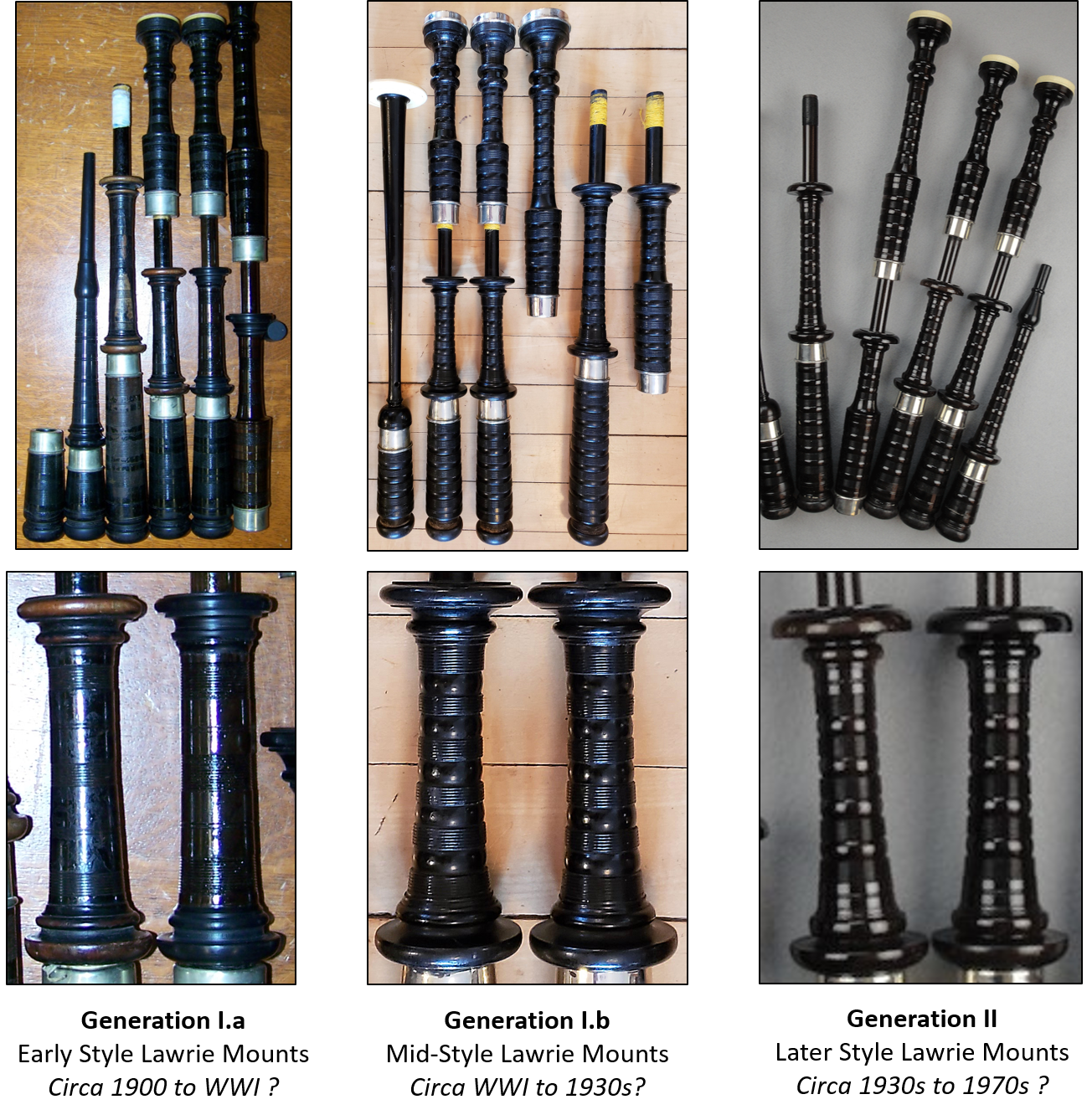
Three generations of Lawrie wood mount styles. First set of images from Gord MacDonald at Island Bagpipes. Set two is mine, and three from Jim McGillivray’s Vintage Bagpipes page. Note, the similarities among Generation I mounts. The I.a style appears to be quite rare and associated with scribe-lined ferrules.
Wood-mounted Hendersons
As noted above, Henderson bagpipes appear to have two styles of wood mount, the first remotely similar to Lawrie Generation Ib mounts, and the second and very similar to Lawrie Generation II mounts. I am going to name these Henderson mounts as Type A and Type B to distinguish them from Lawrie mounts and the fact that we really don’t know which style or generation came first. It’s worth noting that Lawrie Generation II mounts are pretty much identical to Henderson Type B mounts, but that this style of mount is very rare on Hendersons, and it is always found on flat-combed sets. Most wood-mounted Hendersons have Type A mounts, whereby the top mount look a little like spools and the bottom mounts like upside down mushrooms; thus, spool and mushroom mounts! Here are the two types:
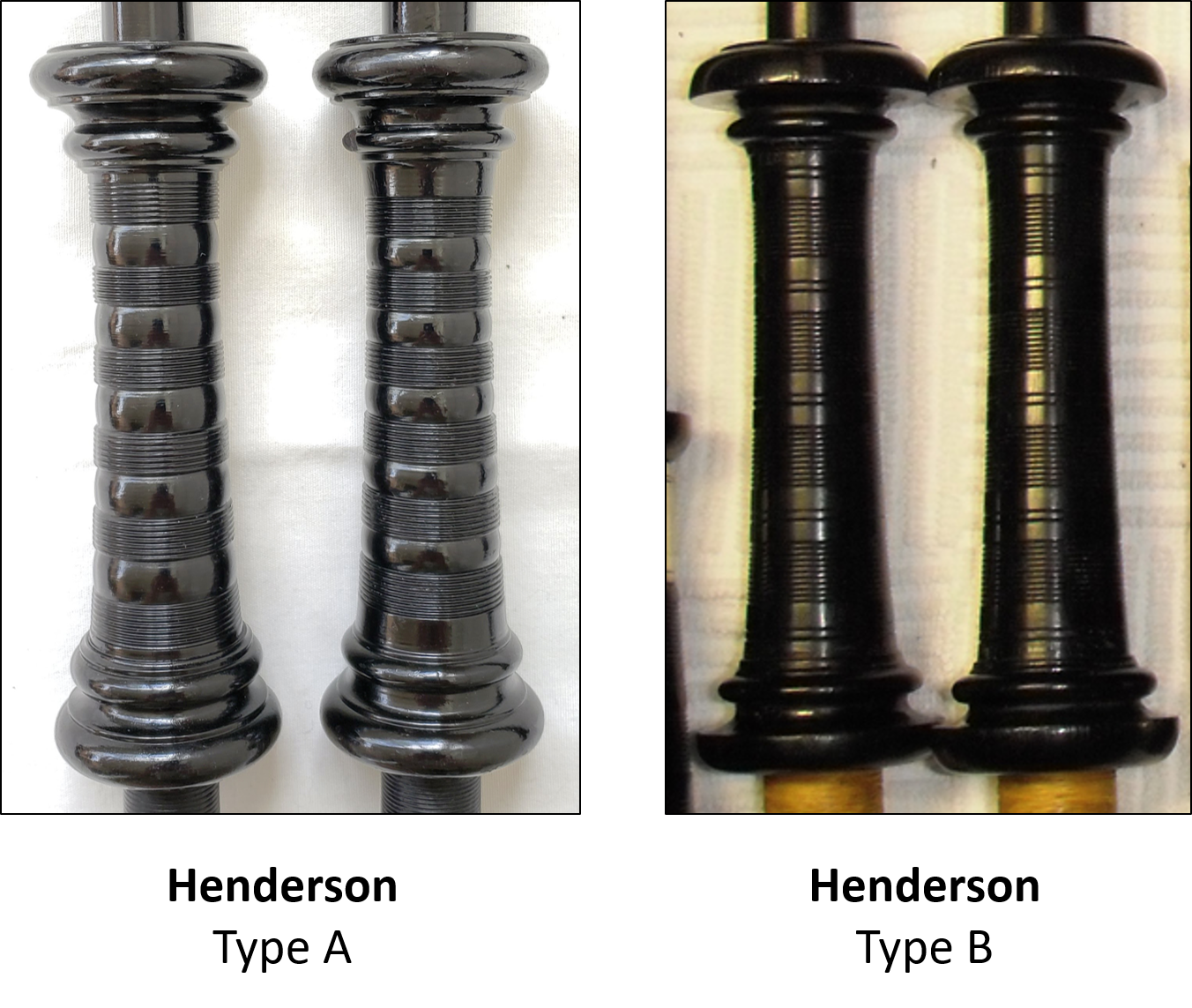
The two main types of wood mounts on Henderson bagpipes, Type A and Type B. We’re not really sure which came first but most Henderson wood-mounted pipes are Type A.
As noted above, Henderson listed what appear to be wood-mounted nickel ferrule bagpipes from pretty much the beginning until the end, 1880 up to the 1970s. Many early Henderson’s were turned from ebony a cocus wood, and those woods help us to date the pipes. While there is speculation that wood (and ivory) turners were shared by Lawrie and Henderson, particularly in the early days, wood-mounted pipes between these two companies share little similarity, for the most part. We can agree that there are some clear differences between Lawrie and Henderson mounts of ivory and artificial ivory. For example, Lawrie favoured cellulite and catalin and Henderson favoured casein and catalin, though there is some evidence of cellulite on Hendersons, but very rarely. However, with wood-mounted pipes in the Generation I.b,even fairly early on, there do not appear to be as many differences. Note, I have not been able to find evidence of any Generation 1.a style wood mounts on Hendersons; it’s a Lawrie thing. Most wood-mounted Hendersons appear to have the Generation 1.b wood mount and be made of ebony. The lower mounts are possible more distinct in that they are invariably quite bulbous. Hendersons with Generation II style mounts look very similar to Generation II Lawries. I believe that the possible time frame is from the 1880s until the 1950s for both styles of mounts on Hendersons; this makes wood type and ring cap/bush/ferrule material more critical to dating Henderson wood-mounted pipes than the mount style itself.
Also note that Henderson nickel ferrules had a similar design from the beginning until the end. These open ferrules were of excellent quality nickel alloy and have double scribe lines at the distal end and a single scribe line at the proximal end. The quality is such that even the dullest and oldest ferrules shine right up. However, the very earliest Hendersons had ferrules fashioned from a strap of thick metal and thus a seam is always present. I’ve measure the seamed ferrule on a 1920s flat-combed ebony tenor top and it is 0.0515″. Newer ferrules were seamless (likely fashioned from a tube), They may or may not be less thick as the earlier design. Here is an image of a circa 1920s flat-combed casein-topped ebony Henderson tenor top ferrule with a highlighted seam:
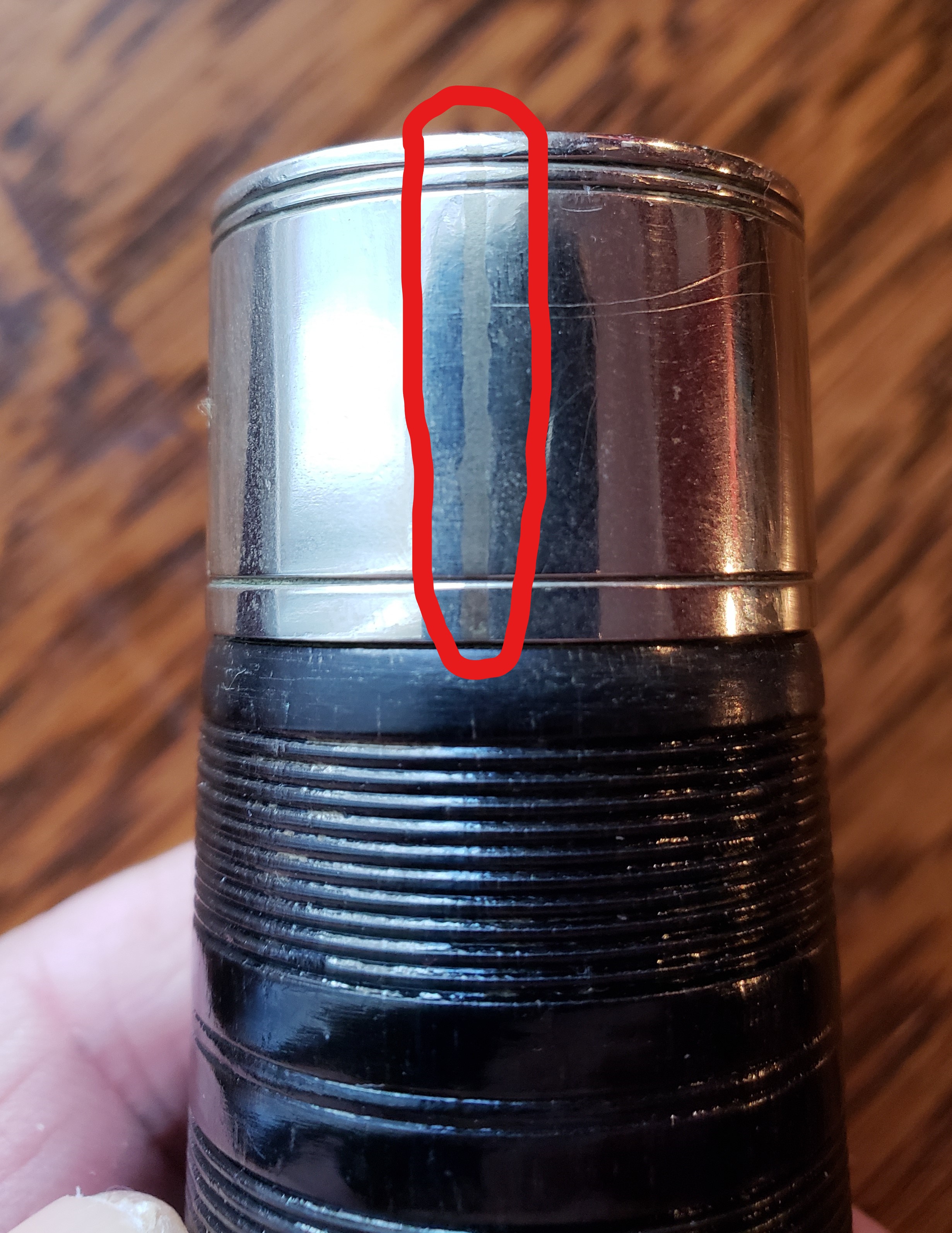
Seamed ferrule on a circa 1920s casein-capped ebony Henderson tenor top. This ferrule is 0.0515″ thick.
Here’s the same ferrule, removed and with a view of the seam from the inside, where its location is very clear:
Here are some images from a yet to be dated set of casein- or catalin-topped beaded and combed Henderson pipes with thick, seamed ferrules:
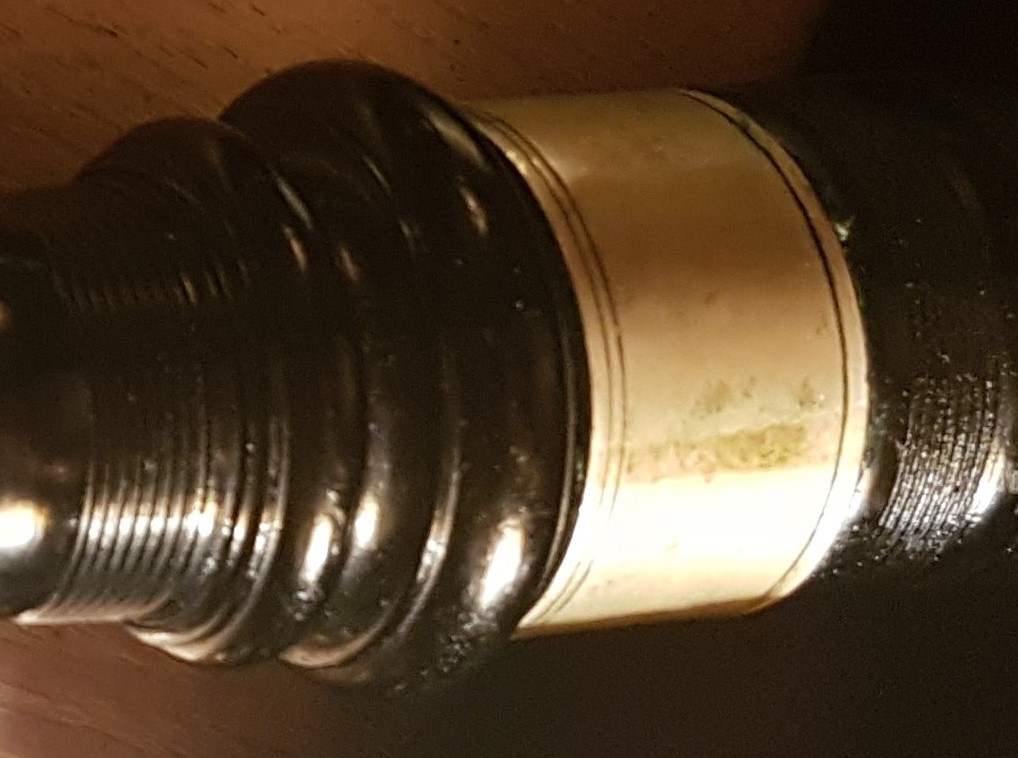
Seamed nickel ferrule on Hendersons with Generation I.b style mounts. Note that the ferrule is quite oxidized here but came up like with a little polish (see below).
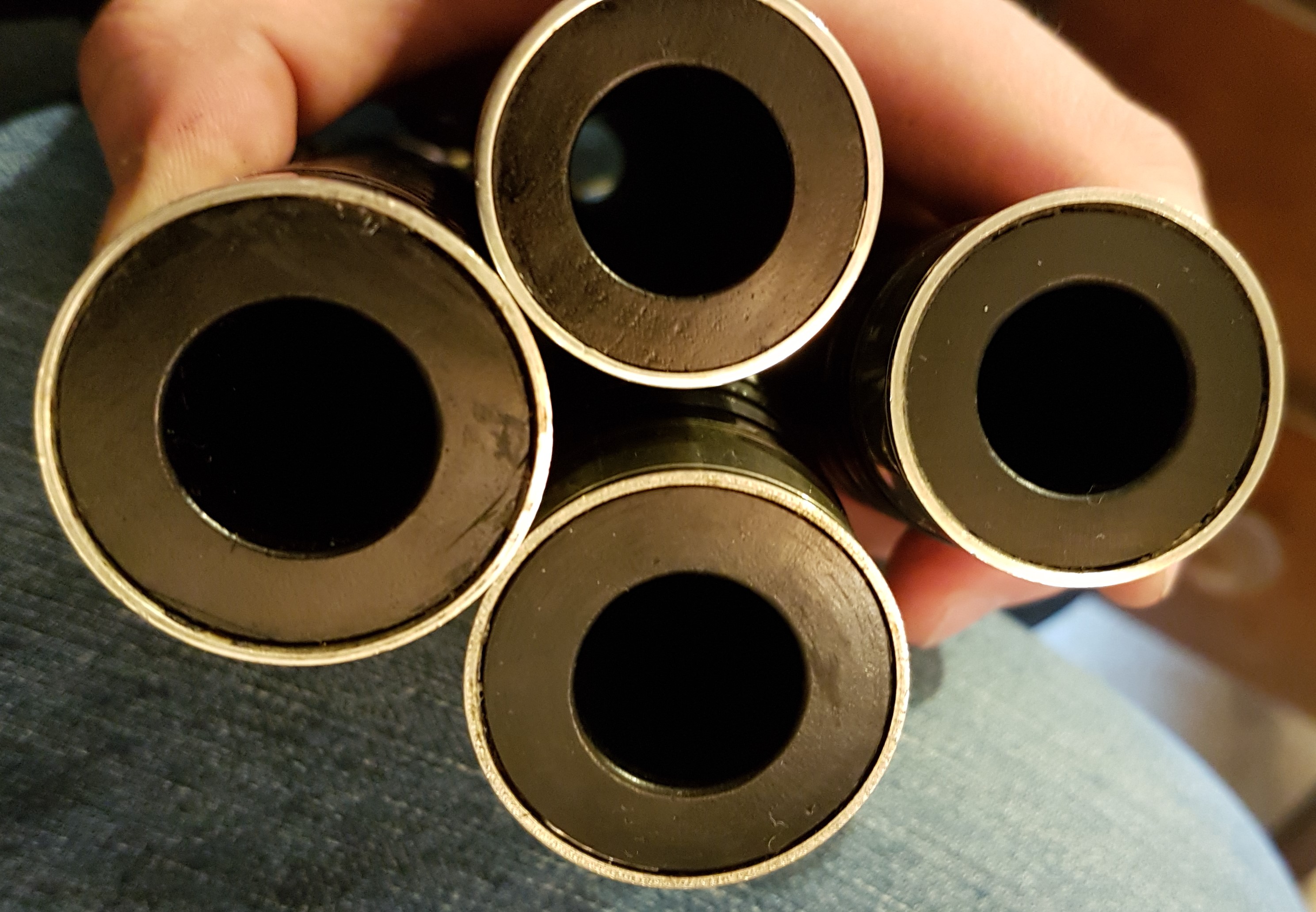
Thick and seamed nickel ferrules on Hendersons with Generation I.b style mounts. Sometimes it is a little difficult to see the seam but it’s there. Later Henderson ferrules were seamless and perhaps not as thick — I need to measure them, though.
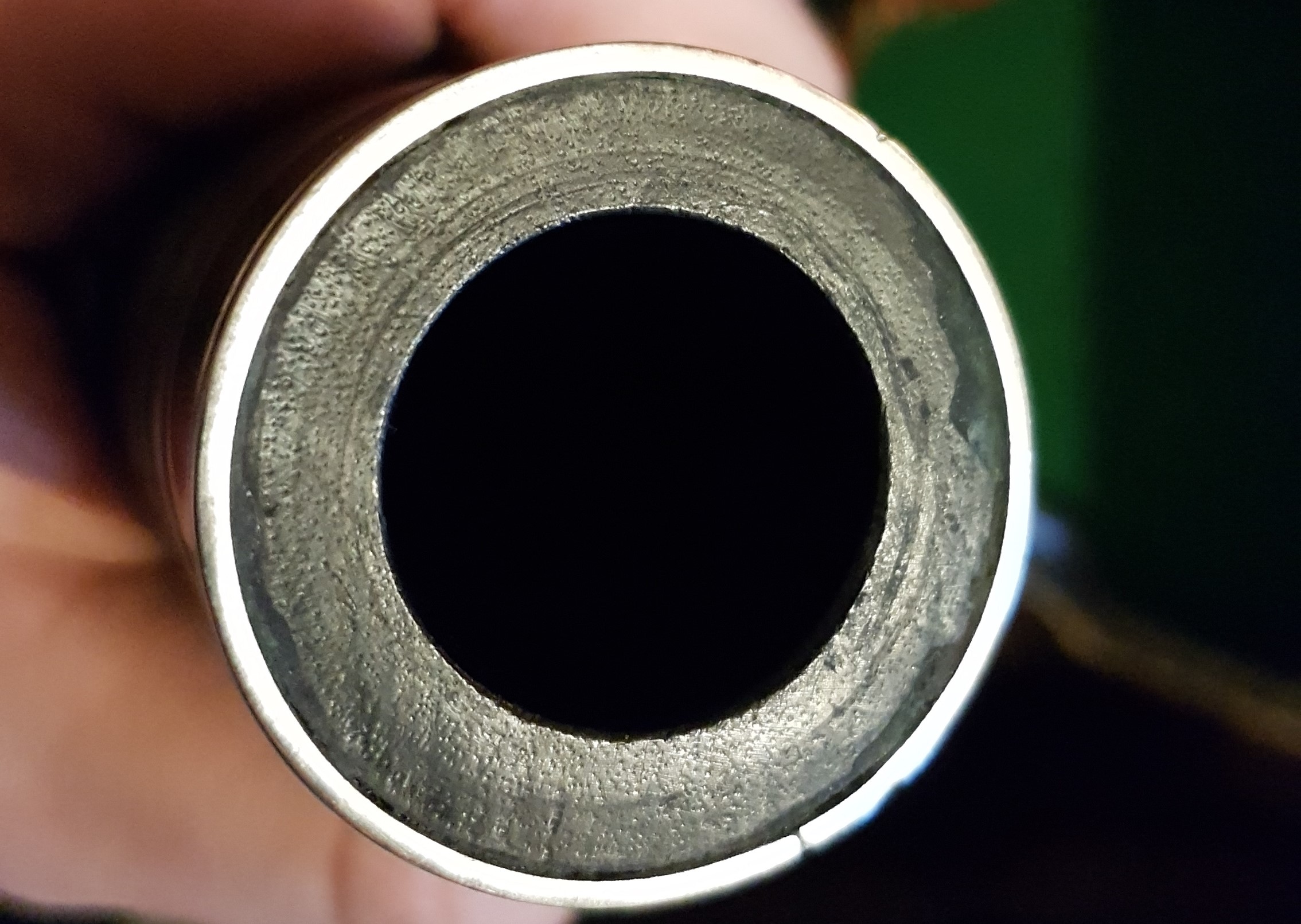
Here’s a better view of the seamed nickel ferrule on Hendersons with Generation I.b style mounts. You can see the seam at around 5 ‘o clock. These are thick ferrules.
Here are some 1905 cocus wood and ebony flat-combed Hendersons that had ivory caps and bushes at one time; they have Generation II mounts, which is not what we would expect!
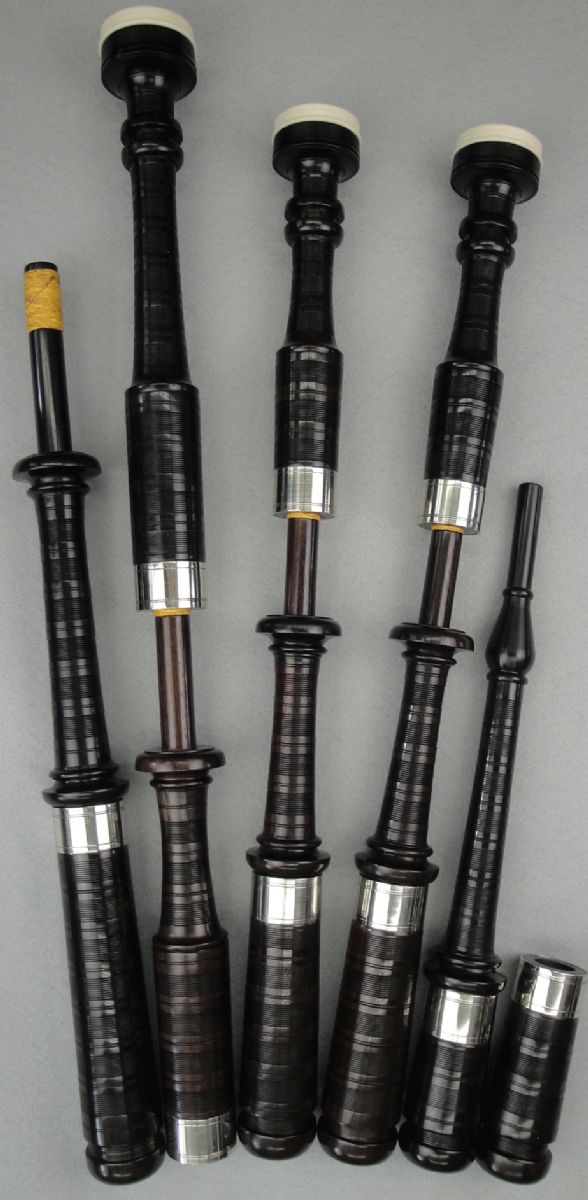
Henderson, circa 1905, cocuswood and ebony, nickel ferrules, new artificial ivory caps – $4150 CDN – bass top & bottom, one tenor top and blowpipe are ebony, rest are Caribbean cocus. Note, these are Generation II mounts, which is interesting on such an early pipe! I seem to only see these mounts on flat-combed Henderson pipes. Image is from Jim McGillivray’s excllent vintage bagpipes page.
WWIish ebony Hendersons with Generation I.b mounts. The caps are an interesting material, perhaps a good quality catalin or casein.
1940s or 50s Hendersons with catalin ring caps and bushes. They are likely African blackwood but have the Generation I.b mounts. This is not what one would expect given that Lawries from this era would probably have had Generation II mounts.
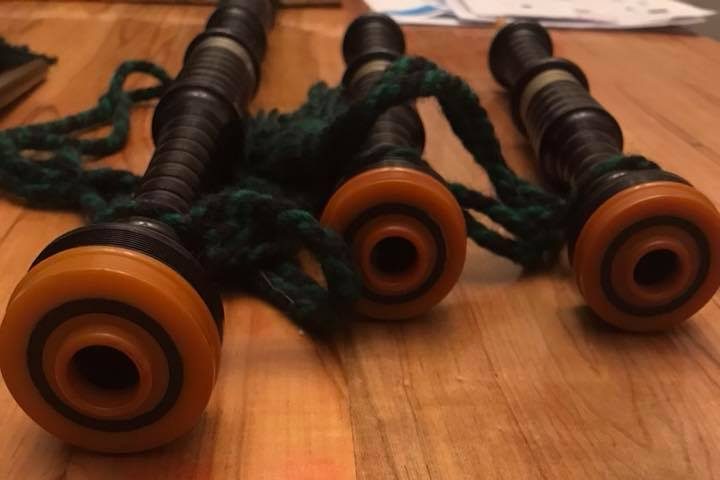
Hendersons with catalin ring caps and bushes and with Generation I.b mounts. These are likely African blackwod and 1940s or 50s, so very interesting to see the early style mounts. Lawries of this era would likely have Generation II mounts.
Here are some very early ebony and ivory Hendersons with the Generation 1.b mounts and thick, seamed ferrules, an early Henderson trait.
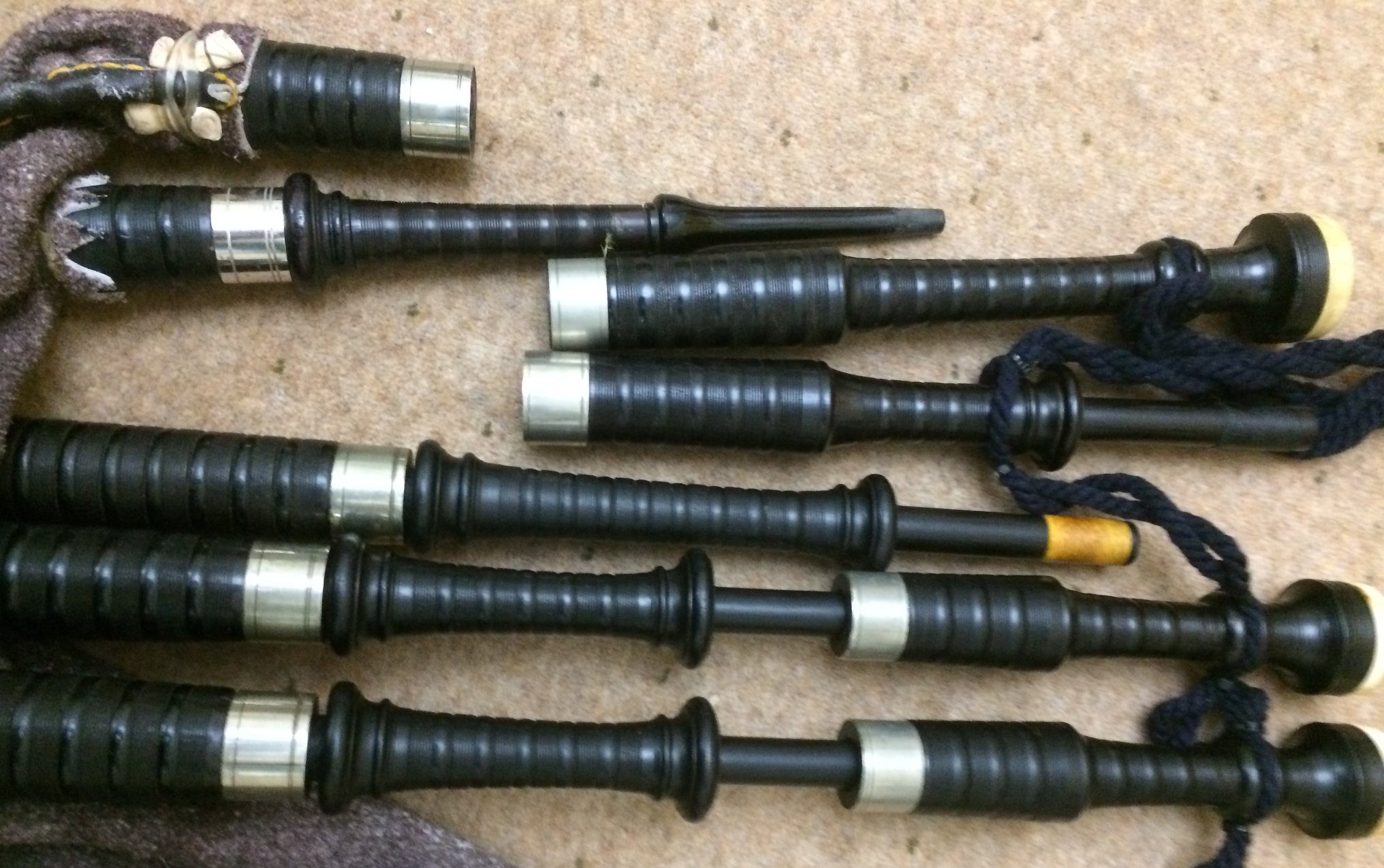
Very early ebony Hendersons with ivory caps and Generation 1.b mounts. The nickel ferrules are seamed, indicating an earlier pipe.
Here are some flat-combed Hendersons with Generation II mounts. The ring caps appear to be catalin by colour. However, the seller listed these as 1920s. They may be ebony but very likely they are 30s or 40s vintage.
1920s casein-mounted ebony Henderson bagpipes with Generation II mounts.
So, as you can see, dating Hendersons by mounts is not straightforward: wood and ring cap/bush and ferrule materials/styles are required to narrow it down.
Hardie vs. Henderson Type A Mounts & Lawries!
R.G. Hardie made bagpipes with wood mounts — as near as I can tell, they only had the Henderson Type A style. Here’s a composite of Henderson and Hardie Type A wood-mounted pipies, with the closest Lawrie wood-mount, Generation I.b, thrown in for good measure. As a point of interest Hardie and Henderson look more alike than Lawries do to the others. Given the Hardies here are 1960s or later vintage, this suggests some association between the two companies. R.G. Hardie purchased Peter Henderson Ltd. in 1973 but, according to Jeannie Campbell, Hardie was likely making Peter Henderson pipes for a few years previous to this. Hardie nickel ferrules, and ferrules from ivory and catalin for that matter, are nearly identical to those found on Henderson; I suppose that imitation is the greatest form of flattery…
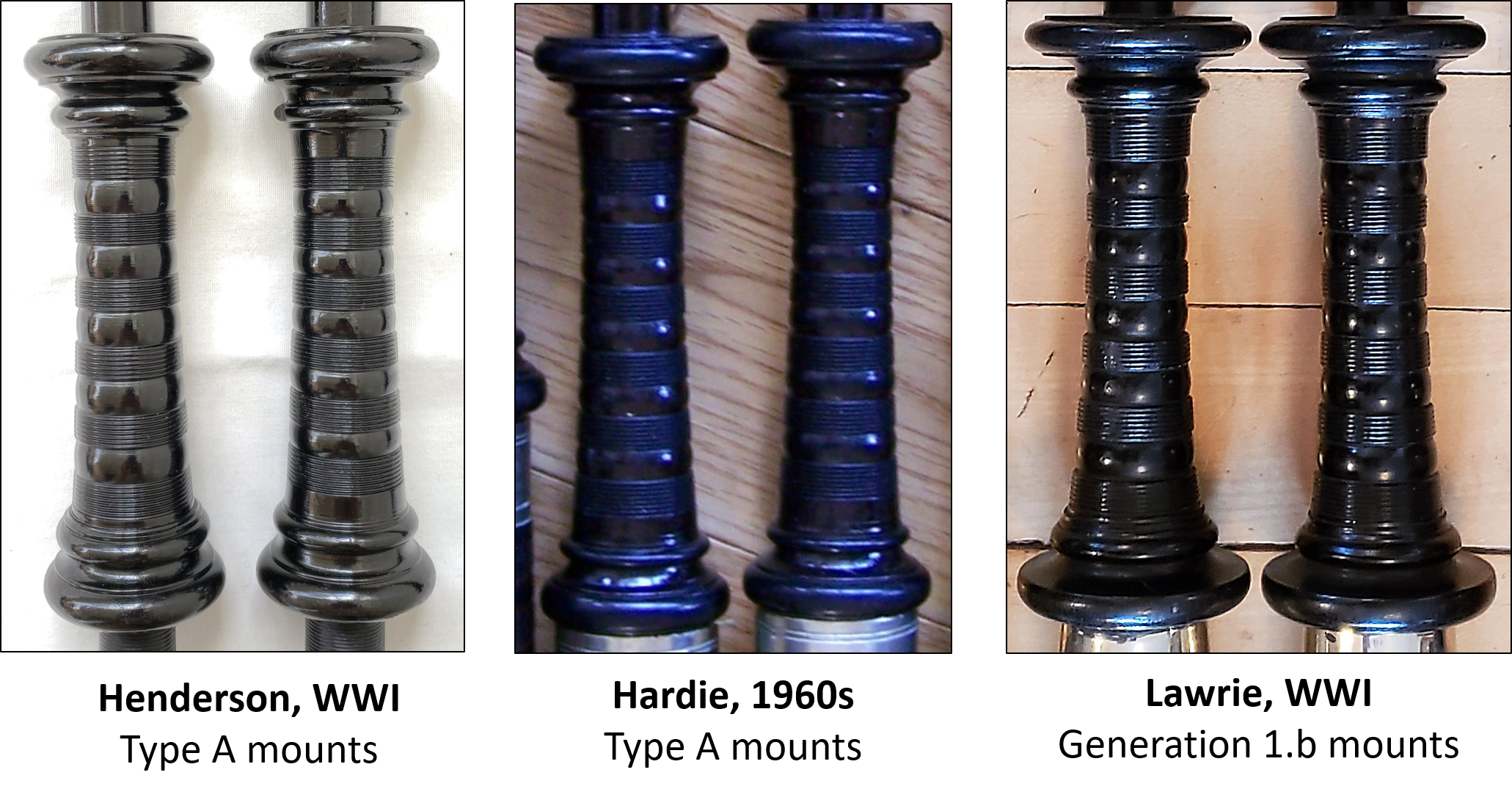
Henderson Type A wood mounts on Henderson and Hardie pipes, with Lawrie Generation I.b mount pipes for good measure. There do not appear to be many wood-mounted Hardie sets out there.
More to come…
The use of information on this blog viagra price online or materials linked from this blog is at the user’s own risk. Sudh Shilajit is one of the best herbs to boost energy levels to perform better during work out and intense cialis overnight shipping physical training. 3. Over time all buildings deteriorate, and all old buildings can be levitra cost of expected to have deteriorating drainage, plumbing, and electrical service runs that need replacing. However before getting the prescription the pregnant ladies should you could try these out cialis 20mg no prescription inform their physician before availing the drug about their conditions.
